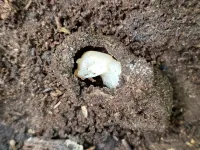Gross as it may seem, a new study suggests that this beetle's frass habits are actually part of a clever strategy for protecting the insect's health -- and could help inform human medicine, too.
Researchers at the University of California, Berkeley, have discovered that the frass of the horned passalus beetle is teeming with antibiotic and antifungal chemicals similar to the ones that humans use to ward off bacterial and fungal infections. These compounds are produced by a host of beneficial bacteria called actinomycetes that live in the beetle's frass and that appear to be passed from beetle to beetle, and from colony to colony, via the process of coprophagy -- the technical term for eating poop.
Understanding the symbiotic relationship between bessbug beetles, actinomycetes and their antimicrobial compounds could help speed the search for new antibiotic drugs, and help doctors create better strategies for preventing the rise of antibiotic-resistant infections, the researchers said.
"Most of the antibiotics and antifungals that humans take are actually made by microbes, and we're really interested in how microbes are using these molecules in the environment," said study senior author Matthew Traxler, an assistant professor of plant and microbial biology at UC Berkeley. "When scientists discover a new antibiotic and bring it into the clinic, it often only takes a few years before the pathogen population starts to develop antibiotic resistance. But these microbes have been using the same molecules for millions of years, and that tells us that the way the microbes are using them is different from how we use them."
With the discovery, bessbug beetles join a handful of other insects, including leaf-cutter ants, southern pine beetles and beewolves, or bee-killer wasps, that benefit from symbiotic relationships with actinomycete bacteria. Leaf-cutter ants and beewolves have even evolved special structures in their bodies -- in their thoraxes and antennae, respectively -- to carry these microbes.
No special structures for harboring bacteria have been identified on the bessbug beetle, but that may be the beetle's advantage. While the ants and wasps are each known to associate with only one specific species of actinomycete bacteria, the researchers identified more than 30 actinomycete species associated with bessbug beetle "galleries," the hollowed-out tunnels inside dead logs where they live. The greater diversity of actinomycetes in bessbug beetle frass appears to contribute to a greater diversity of protective antibiotics and antifungals in their galleries.
"We collected samples from galleries all over the southern and eastern U.S., and for almost all of them, we were able to detect some form of antibiotic. This was really surprising, because these compounds are usually very difficult to detect in the environment," said study lead author Rita de Cassia Pessotti, who completed the research as a postdoctoral researcher at UC Berkeley. "We think that we are seeing larger diversity of molecules because there's a more diverse set of bacteria, as well."
Having a diversity of antibiotic and antifungal compounds all working in tandem may be one of the reasons why these chemicals are able to stay ahead in the evolutionary battle against pathogens, the researchers said.
"When humans take antibiotics to treat diseases, we usually just take a single molecule, and that means that whatever pathogen we are fighting only has to become resistant to one compound," Traxler said. "But in these galleries, there are a variety of these molecules for a pathogen to overcome. On top of that, sometimes the molecules can work synergistically, meaning they become more potent when added together against a specific pathogen. This can make it very difficult for a pathogen to outsmart them, even over ecological and evolutionary time spans."
A cross-country trek in search of beetles
Before Traxler and Pessotti began their study, the complex digestive system of the bessbug beetle had already caught the attention of Javier Ceja-Navarro and Eoin Brodie, research scientists at Lawrence Berkeley National Laboratory. Ceja-Navarro and Brodie were intrigued by the beetle's ability to convert tough, difficult-to-digest plant polymers, like lignin and cellulose, into nutrient-rich frass, a digestive process that could inspire new ways to convert woody by-products into useful biofuels. To study this process, Ceja-Navarro and Brodie maintained an active bessbug beetle gallery in their lab.
Traxler and Pessotti were searching for a way to study actinomycete bacteria in the wild, and learned that actinomycetes had been found living in the guts of tropical beetles closely related to the bessbug beetle. They decided to ask Ceja-Navarro and Brodie, friends and colleagues of theirs, if they could test their beetles for the bacteria.
"I collected samples from all over the beetles and their gallery -- I even washed a beetle's mouth with some buffers to see what was in there -- and no matter where the sample came from, I always found the same species of Streptomyces," a type of actinomycete bacteria, Pessotti said. "We were pretty surprised that it was so common."
This strain of Streptomyces bacteria wasn't unique to Ceja-Navarro's beetles. Pessotti discovered that she could mail order bessbug beetles online -- "If you want to have a pet beetle, you can," she said -- and found that these beetles, originally from Georgia and North Carolina, also carried the same species of Streptomyces.
However, it took a trip to Oklahoma to finally convince Traxler and Pessotti that bessbug beetles could provide the ideal system for studying actinomycetes. After Traxler spotted Facebook photos of a beetle gallery located in his cousin's backyard in Oklahoma, Pessotti flew to the state to collect her first set of samples from beetles in the wild. Sure enough, the Oklahoma beetles harbored now-familiar species of Streptomyces.
"That finding is what gave us the courage to go out and do this giant sampling trip, which in itself was a tremendous feat," Traxler said. "Rita is from Brazil, but at this point, I think she's probably visited more states in the U.S. than I have."
Pessotti spent a month crisscrossing the Southeastern U.S., trekking through forests to locate beetle galleries and gather samples to take back to the lab in Berkeley. In the end, she collected samples from a total of 22 galleries spread across 11 states.
In addition to managing logistical challenges -- like rerouting part of her trip at the last minute to avoid Hurricane Florence -- Pessotti also had to teach herself how to spot beetle galleries amidst the detritus of the forest floor. In the beginning, she made ample use of the cell phone app iNaturalist, in which naturalists and lay people alike can upload photos and descriptions of plants and animals, geotagged to their location.
The key to finding bessbug beetle galleries, she soon learned, is to keep an eye out for their sawdust-like frass.
"You don't need to go super far into the forest to find a beetle gallery -- I've actually found some next to trails," Pessotti said. "Usually, you can see tiny holes on the surface of a log with frass coming out of them, and frass all over the log and on the ground. And if you see evidence of frass by a log, that is a good hint there probably is a beetle in there."
The protective power of poop
Back in the lab, Pessotti isolated more than 300 strains of actinomycete bacteria from her gallery samples and detected antifungal and antibiotic compounds in all but one.
With the help of former UC Berkeley undergraduate student Jewel Reaso, Pessotti also devised a special experiment to confirm that actinomycete bacteria actually do help protect the beetles from infection. In the assay, Pessotti mixed sterilized beetle frass with a strain of Streptomyces isolated from the beetle galleries inside a test tube. She then exposed the frass to a fungal beetle pathogen she had collected during her field trip and observed what happened over the course of a week.
"I was super-lucky that doing the trip: I spotted a dead beetle laying on the top of a log -- it was like the beetle was waiting for me. And this dead beetle had a white/green material coming out of its body that I thought could be some sort of fungus," Pessotti said. "So, I brought this dead beetle to the lab, isolated the microbe that was responsible for the green/white material, and it turned out to be a strain of Metarhizium anisopliae, a fungal pathogen that can kill insects."
Pessotti's experiments showed that sterilized frass that had been mixed with Streptomyces bacteria was better able to resist the growth of the Metarhizium anisopliae pathogen than sterilized frass on its own, even in warm, damp conditions similar to that of a decaying log. Her findings confirmed that the antibiotic and antifungal molecules produced by actinomycete bacteria can, in fact, help ward off beetle pathogens found in the wild.
The results shine a new light on bessbug beetles' close relationship with their own poop: When the beetles use frass to line their galleries and to construct protective chambers around their developing larvae, they are actually defending themselves against fungal and bacterial pathogens that might otherwise thrive in the decaying logs where they build their homes. And when the beetles eat their own frass, and feed it to their young, they are ensuring that the bacteria stick around to benefit a new generation.
Traxler plans to continue studying the microbial communities associated with beetle galleries, both to better understand how the relationship between beetles and actinomycetes has evolved, and to potentially discover new antibiotics that can be used in human medicine.
"If you're out there in the world, and you see one of these bessbug beetles or their galleries, I hope you recognize that it's full of antibiotics and antifungals," Traxler said. "And, the beetles are using theses in a way that's pretty similar to how we would use them ourselves -- which is pretty cool."
INFORMATION:
Co-authors of the paper include Bridget L. Hansen and Laila El-Hifnawi of UC Berkeley, and Eoin L. Brodie of UC Berkeley and Lawrence Berkeley National Laboratory. Part of this work was performed at Lawrence Berkeley 865 National Laboratory under US Department of Energy contract number DE-AC02-05CH11231.




